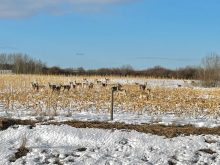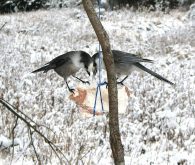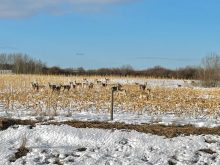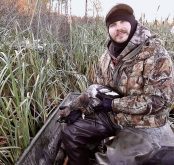Some of the technology offered by the Manitoba Beef Producers to prevent predation may also give farmers a better chance of a payout for a loss.
The three-year project is currently field testing different mitigation strategies on livestock predation, including GPS tracking technology and game cameras.
Janine Wilmot, wildlife conflict biologist and member of the province’s Livestock and Predation Working Group, noted that the GPS alerts, in particular, give farmers a better chance of actually finding a carcass.
Read Also

Manitoba Ag Days plans star-studded speaker lineup
Dragons’ Den panellist Arlene Dickinson among speaker series highlight for 2026 Manitoba Ag Days in Brandon, alongside slate of agriculture experts.
The Manitoba Agricultural Services Corporation (MASC) requires a carcass and sufficient evidence that an animal was killed for a successful claim under their wildlife damage compensation program.
“One thing I liked about them being able to track the movement of the livestock is that (the farmers) do receive an alert that indicates that they’re running for some unknown reason or whatever the case may be,” Wilmot said.
Predation claims have been a sticking point in outdoor livestock sectors for years. Farmers have previously expressed frustration over adjuster responsiveness, or lack of option in cases where livestock are taken and no carcass can be found.
Game cameras, however, confirm the presence and type of predators that may be in the area, pilot lead Ray Bittner suggested during a June 21 field day.
Adjusters require enough carcass to establish that an animal was attacked and was alive at the time of the attack, such as signs of a struggle, field day attendees heard. Producers can expect 90 per cent of an animal’s value in those cases.
Where cases are more dubious, such as if a carcass is too eaten to establish life at the time of attack, that coverage drops to 45 per cent of an animal’s value. Skeletons in the field, or lack of a carcass, lead to no payout.
MASC will work off photos, and producers were encouraged to take as many as possible as soon as possible after a loss, attendees were told. Producers were also told to report the claim within 72 hours for the best chance of success.
Even if a farmer can’t get compensation for a loss, Wilmot said, producers may still want to call their local conservation office.
In some cases, such as with a cougar, which is a protected species, kills are not eligible under MASC’s program, she noted, but added that conservation offices would certainly want to know if there are local issues with that kind of animal.
“They’re monitoring what’s occurring on the landscape in their area,” she said. “There are other management actions that can be taken by provincial staff if it’s felt to be warranted for that particular situation, but if they’re not aware of what’s happening on the landscape, they don’t have the ability to even contemplate some of those additional actions.”















